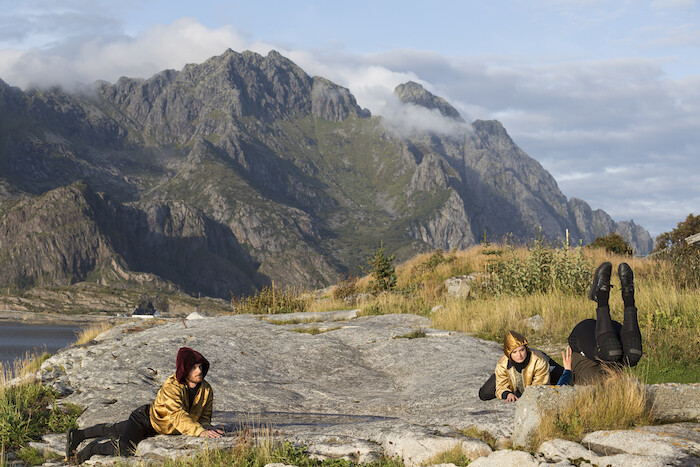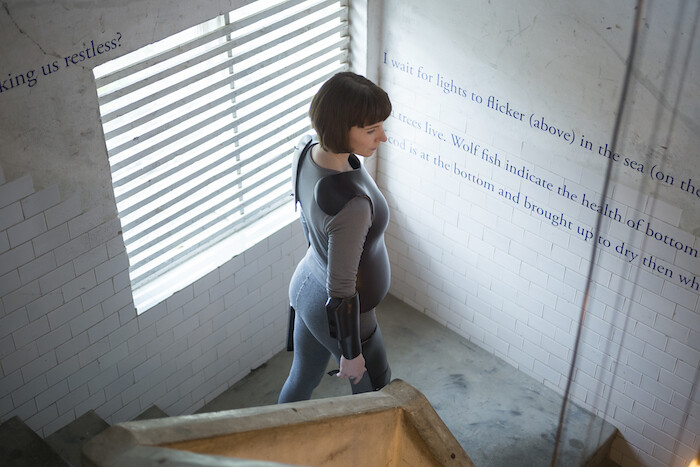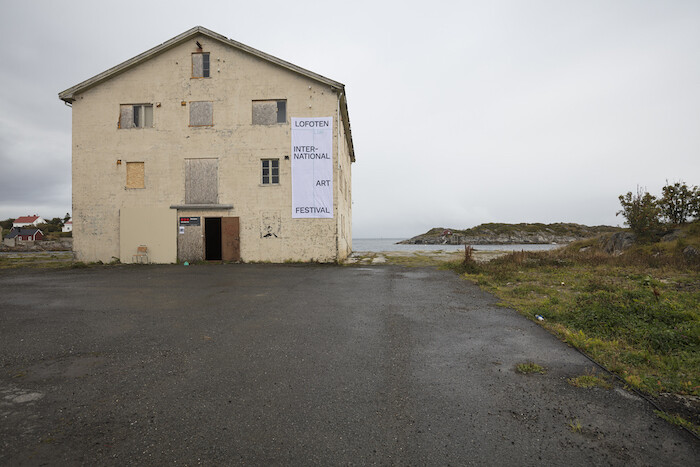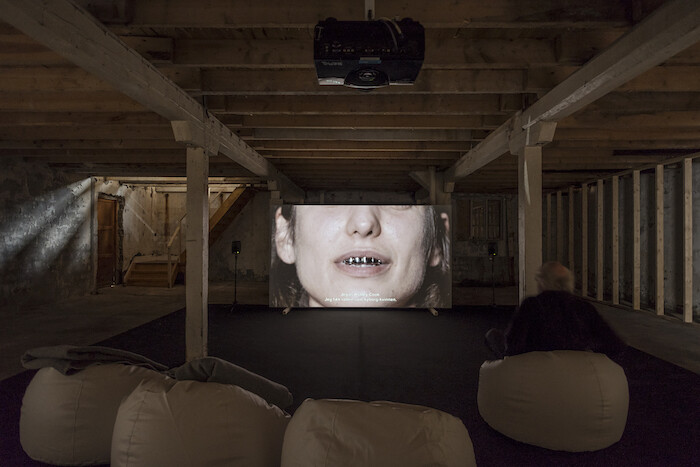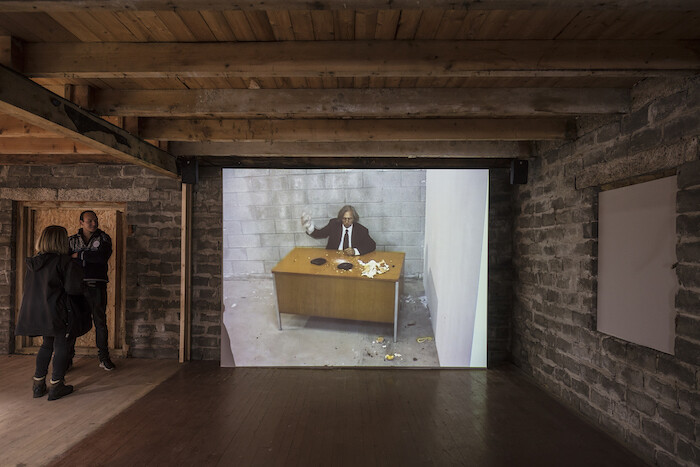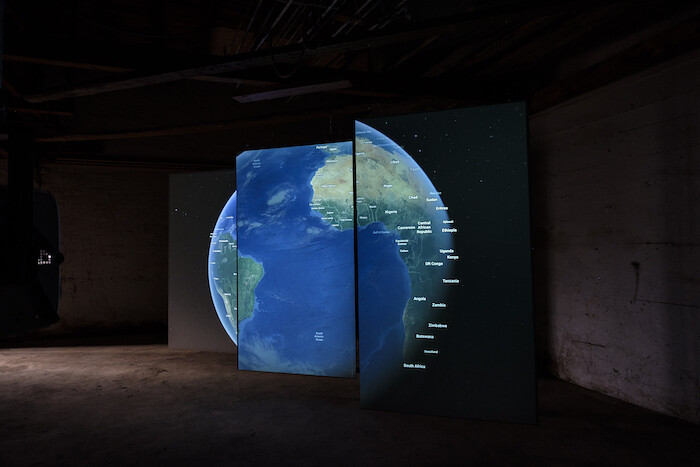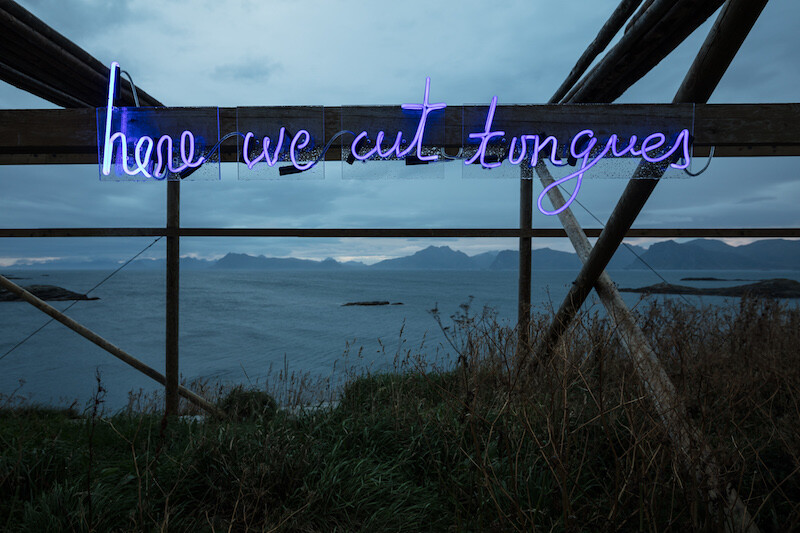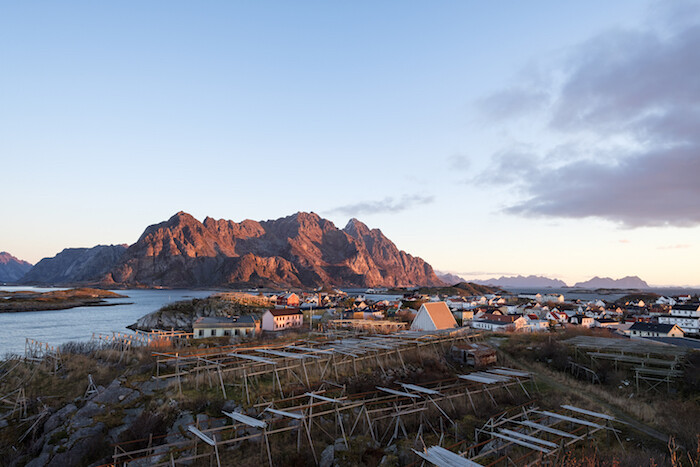You put on headphones and wander across a football field at the end of the world. There are instructions: “Go to the corner of the field, or if there is someone there, stand at the goal line at a place where you can see the entire pitch.” From an iPod shuffle emerge four narratives: a Japanese folktale, two stories written by the artist who made the work, and one by Walter Benjamin, in which a mountainside restauranteur’s livelihood is threatened by the picturesque location’s appeal for suicides, are followed, inexplicably, by the novelty song “I’m my own grandpa.” Daisuke Kosugi’s sound work Good Name (Bad Phrase) (2017) is set in the soccer stadium in Henningsvaer, a fishing village (population: 460) in Lofoten, an archipelago on the northwestern Norwegian coast. Beyond that pitch is the Norwegian Sea, scattered islands dominated by enormous peaks, and a sky so blue it merges with the ocean.
At LIAF, a biennial that has been taking place in Lofoten since 1991, landscape is a large, looming subject that demands a response from artists, curators, and viewers alike. The regional economy relies heavily on the natural environment, from whaling and fishing industries to tourism, and the territory is also a reminder of the Norwegian economy’s dependence on oil, as the Lofoten archipelago sits above a reserve presumed to be worth over 65 billion dollars.(1) Until now environmental reasons have prevented the region from being excavated, but politicians from both side of the Norwegian aisle have recently reconsidered overturning its moratorium on drilling. There is a tension between the dramatic natural environment—mountains dropping off into the sea, chains of islands and snowy peaks, the midnight sun, and the northern lights—and what it represents on an infrastructural level for Norway and the rest of the world, both in terms of the oil-based economy and as an example of the effects of human actions and interventions.
For “I Taste the Future,” curators Heidi Ballet and Milena Høgsberg asked the participating artists to imagine life 150 years from now. This curatorial premise used science fiction as a method, a way of thinking, to reflect current anxieties by looking ahead of them. About half of the nineteen artists and collectives included in the exhibition produced new commissions, but even previously existing works resonated with its focus. Lili Reynaud-Dewar’s 2016 video TEETH, GUMS, MACHINES, FUTURE, SOCIETY (TGMFS), presented at the Fredriksenbruket, hones in on the “grill,” a type of metal jewelry worn over the teeth. The grill is figured as an artificial part in a futuristic human body—referencing Donna Haraway’s Cyborg Manifesto (1984)—as well as a mark of American hip hop culture. Shot in Memphis, Tennessee, where Martin Luther King was assassinated following a demonstration, the video offers the cyborg as a prism through which to examine politics of identity, race, and gender.
Haraway’s ideas inform a number of the works on view, explicitly or otherwise, which prompts the inclusion of Fabrizio Terranova’s 90-minute video-portrait Donna Haraway: Story Telling for Earthly Survival (2016), screened at the Trevarefabrikken. Focusing on Haraway’s personal history and interest in science fiction through the framework of her thinking on gender and ecology, the interview, set in Haraway’s California home, offers a theoretical background to the questions at the heart of this biennial.
The cyborg reappears in Adam Linder’s performance To Gear a Joan (2017) as a ghostly female figure singing about the plunder of nature by human beings. The Norwegian vocalist Stine Janvin Motland roamed Trevarefabrikken’s hall and the streets around it in a carbon fiber costume. Her futuristic outfit became a second skin, one that can also modulate into a seat and a music stand, and includes a speaker in the arm. Eglė Budvytytė’s performance Liquid Power Has No Shame (2017) also left the exhibition space as three performers led viewers out into the street, dancing in the direction of the mountain range at the end of the block. As the viewers stood above them, the trio climbed down the mountain, stopped at a large rock, and engaged in an intimate, ritualistic exchange in which one lay on the ground as the other two pinned them down using stones and then poured water into their bellybuttons. They were so close to one another, so engrossed, they became part of the view—mysterious, inexplicable, somehow magical—then walked across the cliff’s edge until they disappeared into the horizon.
Michala Paludan’s Midnight Safari (2017), a photo-essay on labor in Lofoten, looked into fishing, oil, and tourism. It was presented on three tables, an installation that cites methodologies of presentation in science museums more than the personal account the artist has created in the course of a stay on the island. The photographs veer from a photo of protestors with a “stop whaling” sign to a personal remnant: a bed with crumpled sheets. The title refers to a tourist attraction in Henningsvaer, which enjoys the midnight sun for two months each year. The work does double duty in this exhibition, zooming in on the local context and suggesting that these could be specificities to which we should all look to draw conclusions about labor, economy, and society.
The subjects of the exhibition—oil, trade, climate change, cyborgs, death, technology, and destruction—could all make for a grim view of the future. Which is, of course, a sad reflection on 2017 rather than 2167. You can learn a lot about a culture—its past and present—from the stories it tells of its future, whether in H.G. Wells or William Gibson. Looking to the future is a phenomenon that we as a society tune in and out of periodically, and it is especially visible at times of flux. Italian futurism emerged in the volatile years preceding World War I; many of the masterpieces of science fiction, from Dune (1965) to Do Androids Dream of Electric Sheep (1968), date from the turbulent 1960s. We are living through another futuristic moment (our lives conditioned by drone warfare, all-seeing governments, and a celebrity-turned-president, really the stuff of science fiction). The image of the future this biennial represents, however, is not only technology-heavy but draws from its surroundings to ask questions about the natural world and human intervention in it.
But the future we imagine can still transform, still provide a possibility of escape. “I Taste the Future” makes an image of what we stand at risk to lose, but it is the same natural environment against which Budvytytė’s performance fights for its individual, unique beauty. Between the landscape and the stories, the splendor and fear, the experience of the biennial mirrored the feeling of Kosugi’s artwork: it made time and space to stand silently at the goal line, look at the astonishing world around, and hope.

